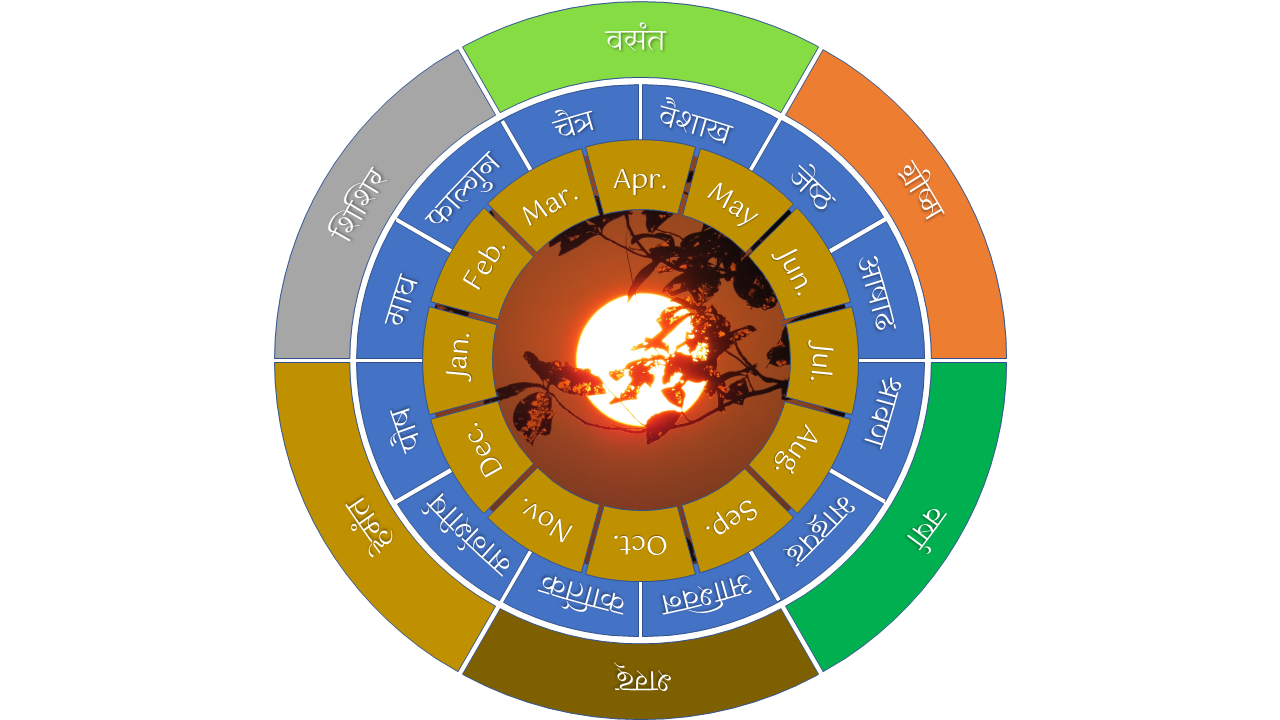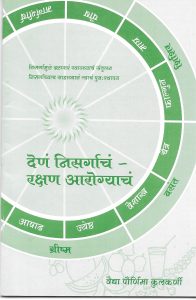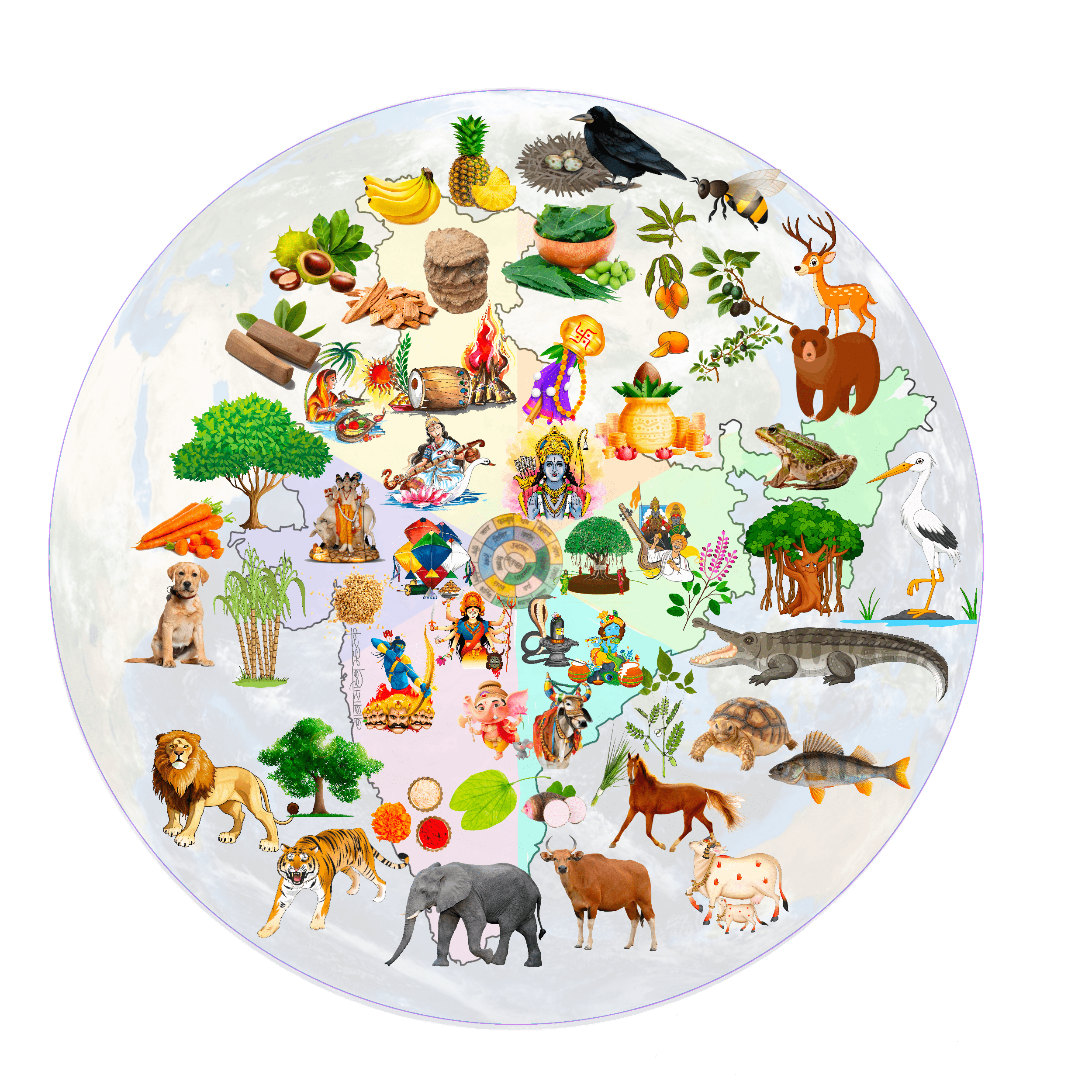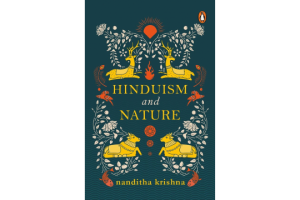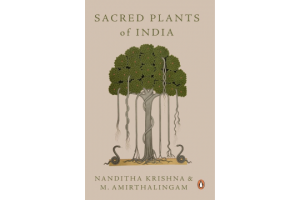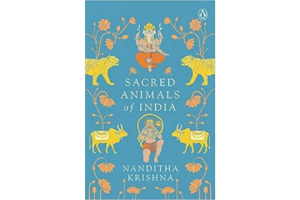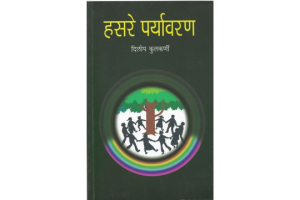Indian Culture And Nature – Part 3
Indian Festivals, Celebrations And Biodiversity Conservation
These days we see following type of pictures of Ego Vs Eco being shared through various social media platforms like WhatsApp, Facebook, Twitter or even we share it ourselves. However no one tells anyone, in reality, how to achieve the Eco part shown in this picture.
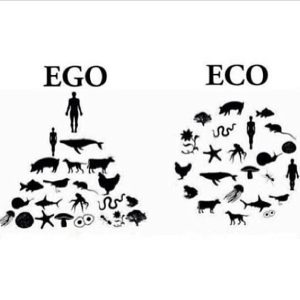
In accordance with this, today we will take a look at a very much neglected but excellent aspect of Indian culture – Indian festivals, celebrations and their inextricable connection with nature. Bringing the Eco lifestyle into action!
Drifting in the stream of Western materialism, we still celebrate our festivals to some extent, but rarely do we think of nature while celebrating any festival. But our wise and experienced forefathers have thought about many things in nature and used them in a controlled and cyclic manner in every festival. Controlled and cyclical in the sense that nature is essential to human beings, the purpose of festivals is for human happiness, social harmony, while festivals are to utilize or worship various things in nature on certain days every year, to express respect and love for them.
For this to happen, we must first be able to recognize those things in nature, for example various plants, above all those things must survive. According to Ayurved, many things that are used for festivals are of medicinal use to us. Also anything that exists in nature is necessary for the ecological balance. It is anytime beneficial to have knowledge of all such things. The bigger meaning of this is that it is our duty to protect all those things and consciously preserve the nature. Directly or indirectly we get this message through our festivals and not just eat, drink, dance and have fun!
We are trying to present here, in few words, the festivals and celebrations of Indian culture and their close relationship with nature. The purpose behind this is to raise the feeling of gratitude, to develop respect towards our ancestors, culture and practically achieve nature conservation through our action.
How To Use The Following Circular Menu?
We have arranged this storyticle in a slightly innovative way so that it does not become difficult to read, boring and dodgy by giving information about all the festivals of six seasons and twelve months on single scrollable page.
1. Click on any season in the circles below.
2. Click on the name of any of the three Marathi month that follows your click on the season.
3. Below you will find the names of the festivals of that month and the connection of that festival with nature in the form of a list of various things in nature, in a tabular format.
4. If the information is not visible in front of the festival, due to the smartphone screen size limit, click on any Festival name to read the information.
| Chaitra Festivals | Festival's Association With Nature |
|---|---|
| Samvatsarpratipada (Gudhipadwa) | Plants: 1. Neem (flowers, leaves, twigs), 2. Pepper, 3. Asafoetida (Hing), 4. Cumin, 5. Celery, 6. Rose, 7. Reed (Bamboo), 8. Mango (leaves, twigs), 9. Marigold and flowers of various native plants, 10. Oil, 11. Sandalwood, 12. Dawna (Indian Wormwood), 13. Sugarcane (Jaggery, Sugar (lumps)), 14. Chickpea (Chane), 15. Rice (Akshata), 16. Ripe Pumpkin, 17. Mugdal, 18. Gram Dal (Puran) Animals: 1. Cow (dung), 2. Bull Birds: 1. Cuckoo Insects: 1. Honeybee (Honey) Others: 1. Salt |
| ShreeRamnavami | Plants: 1. Ginger (dried), 2. Bullock's Heart (Ramphal), 3. Mango (leaves), 4. Coconut (Shriphal) Animals: 1. Monkey, 2. Bear, 3. Jatayu, 4. Boar, 5. Kanchanmrug |
| Dolotsav | Plants: 1. Rice (Akshata) Animals: 1. Cow (Ghee) |
| Gauriutsav | Plants: 1. Various Indigenous fruits, 2. Mango (Kairi), 3. Gram |
| Hanumanjayanti | Plants: 1. Oil, 2. Shendur, 3. Mango (leaves), 4. Various Indigenous fruits Animals: 1. Monkey, 2. Ape |
| Vaishakh Festivals | Festival's Association With Nature |
|---|---|
| Akshaytrutiya | Plants: 1. Mango (Panhe), 2. Sandalwood, 3. Various grains, 4. Cotton, 5. Melon, 6. Pimpal (Fig Tree) |
| Nrusinhjayanti | Plants: 1. Sesame seeds, 2. Emblica (Amla), 3. Various grains Animals: 1. Cow Powers: 1. Nrusinh |
| Jyeshth Festivals | Festival's Association With Nature |
|---|---|
| Gangotsav (Gangadashahara) | Plant: 1. Sesame seeds, 2. Barley, 3. Saktu, 4. Mangoes and various native fruits Animals: 1. Cow (Ghrut, Ghee), 2. Fish, 3. Frog, 4. Crocodile, 5. Other aquatic animals Birds: 1. Swan, 2. Heron Rivers: 1. Ganga, 2. Krishna, 3. Venna, 4. Godavari, 5. Narmada, 6. Yamuna |
| VatSavitri / Vat Paurnima | Plants: 1. Banyan Tree, 2. Sandalwood, 3. Flowers of various Indigenous plants, 4. Holy Basil, 5. Coconut (dry), 6. Dried Dates (Kharik), 7. Almonds, 8. Various Indigenous fruits Animals: 1. Buffalo (male), 2. Cow (Panchamrut) Insects: 1. Honeybee (Honey) |
| Ashadh Festivals | Festival's Association With Nature |
|---|---|
| Mahaekadashi / Devshayani Ekadashi | Plants: 1. Emblica (Amla), 2. Dhatri, 3. Holy Basil, 4. Various Indigenous fruits, 5. Flowers of various native plants |
| Chaturmas | Plants: 1. Doob Grass (Doorva), 2. Rice (Paddy), 3. Moog, 4. Barley, 5. Sesame seeds, 6. Green Pea, 7. Wheat, 8. Salt (Sea-salt), 9. Jackfruit, 10. Mango, 11. Coconut (Shriphal), 12. Banana Animals: Cow (Milk, Curd, Ghee) |
| Gurupaurnima | Plants: 1. Audumber (Cluster Fig) |
| Shravan Festivals | Festival's Association With Nature |
|---|---|
| Nagpanchamee | Plants: 1. Doob Grass (Doorva), 2. Sandalwood, 3. Kewda, 4. Various trees where snakes inhabit, 5. Rice/Soarghum (popcorn), 6. Gram, 7. Raktchandan, 8. Turmeric Animals: 1. Cobra, 2. Cow (milk, curd, ghee), 3. Other types of snakes Rivers: 1. Yamuna |
| Mangalagauree | Plants: 1. Coconut (Shrifal), 2. Prickly Chaff-flower (Aghada) leaves, 3. Radish Pods (Mogari), 4. Doob Grass (Doorva), 5. Gram, 6. False Daisy (Maka) leaves, 7. Stone Apple (Bael) leaves, 8. Khejri (Shami) leaves, 9. Betel leaves, 10. Dorali (leaves), 11. Wheat, 12. Coconut (dried), 13. Dry Dates (Kharik), 14. Almonds, 15. Jaggery, 16. Guava 17. Fragrant oil, 18. Mugdal, 19. Cumin, 20. Sesame seeds, 21. Jasmine (leaves), 22. Indian jujube (Bori) leaves, 23. Thorn Apple (Dhotra/Datura) leaves, 24. Holy Basil, 25. Oleander (Kanheri) leaves, 26. Crown flower (Rui) leaves, 27. Arjun/Arjunasadda (leaves), 28. Vishnukant (leaves), 29. Royal Jasmine (Jai) leaves, 30. Indian Chrysanthemum (Shevanti) leaves, 31. Pomegranate (leaves) Animals: 1. Cow (Milk, Curd, Ghee) Insects: 1. Honeybee (Honey) |
| Sheetala Saptamee | Plants: 1. Cucumber leaf |
| Shravanee Paurnima | Plants: 1. Sandalwood Animals: 1. Cow (Milk, Panchagavya) |
| Povatee Paurnima | Plants: 1. Cotton, 2. Reed Animals: 1. Cow (Milk, Pancagavya, Dhup (Incense)), 2. Cobra |
| Naralee Paurnima | Plants: 1. Coconut (Shriphal), 2. Rice, 3. White Mustard Powers: 1. Sea |
| ShreeKrushnajanmashtamee /Gokulashtamee | Plants: 1. Ginger (dried), 2. Rice (Pohe), 3. Coconut (Shriphal) Animals: 1. Cow (Curd, Milk, Butter), 2. Cobra, 3. Mountain |
| Pithoree Amawasya | Plants: 1. Gram |
| Pola (Vrushabhotsav) | Plants: 1. Gram, 2. The bark or root of the Palas tree Animals: 1. Bull, 2. Nandi, 3. Cow Others: 1. Cinnabar (Hingul) |
| Bhadrapad Festivals | Festival's Association With Nature |
|---|---|
| Hartalika | Plants: 1. Stone Apple (Bael) leaves, 2. Doob Grass (Doorva), 3. Bengal Dayflower (Kena), 4. Crown flower (Rui), 5. Tulsi, 6. Sita Ashok (leaves), 7. Emblica (Amla) leaves, 8. Doorvankur. 9. Oleander (Kanheri) (Leaves), 10. Burflower-tree (Kadamba) leaves. 11. Indian Pennywort (Brahmi) leaves, 12. Thorn Apple (Dhotra/Datura) leaves, 13. Prickly Chaff-flower (Aghada) leaves, 14. Stone Apple (Bael) leaves, 15. Champa (Chafa) flowers, 16. Kewda (flowers), 17. Oleander (Kanheri) flowers, 18. Spanish cherry (Bakul) flowers, 19. Thorn Apple (Dhotra/Datura) flowers, 20. Lotus (flowers), 21. Indian Chrysanthemum (Shevanti) flowers, 22. Hibiscus (flowers), 23. Arabian Jasmine (flowers), 24. Sita Ashok (flowers) Animals: Cow (Curd, Milk, Ghee) Insects: Honeybee (Honey) Others: River, 2. Sand, 3. Soil |
| Ganeshchaturthee | Plants: 1. Doob Grass (Doorva), 2. Rice (Akshata, Modak), 3. Sandalwood, 4. Perl Millet, 5. Sugarcane (Jaggery), 6. Shendur, 7. Holy Basil, 8. Ketaki, 9. Shami (leaves), 10. Prickly Chaff-flower (Aghada), 11. Coconut (Shriphal), 12. Sesame seeds, 13. Dry Dates (Kharik), 14. Almonds, 15. Red Lotus, 16. Mandar (flowers), 17. Champa (Chafa) flowers, 18. Kewda (flowers), 19. Asian pigeonwings (Gokarna) flowers, 20. Royal Jasmine (Jai) flowers, 21. Hibiscus (flowers), 22. Indian Chrysanthemum (Shevanti) flowers, 23. Rose (flowers), 24. Night Jasmine (Parijatak) flowers, 25. Radish Pods (Mogari) leaves, 26. False Daisy (Maka) leaves, 27. Stone Apple (Bael) leaves, 28. White Doob Grass (Doorva) leaves, 29. Indian jujube (Bori) leaves, 30. Thorn Apple (Dhotra/Datura) leaves, 31. Dorali (leaves), 32. Oleander (Kanheri) (Leaves), 33. Crown flower (Rui) leaves, 34. Arjun/Arjunasadda (leaves), 35. Vishnukant (leaves), 36. Pomegranate (leaves), 37. Cedar (leaves), 38. White Marwa (leaves), 39. Pimpal (Fig tree) leaves, 40. Royal Jasmine (Jai) leaves, 41. Kewda (leaves), 42. Agastya Patra (leaves) Animals: 1. Cow (Incense, Panchamrut), 2. Elephant, 3. Rat Others: 1. Abeer 2. Soil |
| Rushipanchamee | Plants: 1. Prickly Chaff-flower (Aghada), 2. Turmeric, 3. Areca nut, 4. Tubers/Roots, 5. Rice (Akshata), 6. Balsam Animals: 1. Cow (Cow dung, Panchagavya), 2. Bull Rivers: 1. Ganga Others: Lake, 2. Well, 3. Soil |
| Jyeshthagauree / Durgashtamee | Plants: 1. Doob Grass (Doorva), 2. Prickly Chaff-flower (Aghada), 3. Miscellaneous grains, 4. Coconut (dry), 5. Dry Dates (Kharik), 6. Kewda Animals: 1. Cow (Milk, Curd), 2. Tiger, 3. Lion |
| Vamandwadashee/ Onam (Malabar) | Plants: 1. Flowers of various native plants Animals: 2. Cow (Milk, Curd) |
| Anantchaturthee | Plants: 1. Halfa Grass (Darbha/Kush), 2. Doob Grass (Doorva), 3. Prickly Chaff-flower (Aghada) Others: 1. Silk threads |
| Mahalay Paksh/ Pitrupaksh | Plants: 1. Doob Grass (Doorva), 2. Prickly Chaff-flower (Aghada), 3. Flowers of various indigenous plants, 4. Holy Basil, 5. Verdure (Vegetables) Animals: 1. Cow |
| Ashwin Festivals | Festival's Association With Nature |
|---|---|
| Navratra Mahotsav | Plants: 1. Flowers of various indigenous plants, 2. Shendur, 3. Perl Millet, 4. Coconut (Shrifal), 5. Betel leaves, 6. Seven grains (Barley, Wheat, Sesame, Moong, Rale, Save and Chickpea (Chane)), 7. Doob Grass (Doorva), 8. Rice (Akshata), 9. Areca nut, 10. Lemon Others: 1. Soil, 2. Holy Ash (Bhasm) |
| Vijayadashamee (Dasara) | Plants: 1. Marigold flowers, 2. Sesame flowers, 3. Mango (leaves), 4. Aapta, 5. Khejri (Shami), 6. Perl Millet (leaves), 7. Sorghum (Jwari) leaves, 8. Wheat seedlings, 9. Areca nut, 10. Mandar tree, 11. Rice longer, 12. Grass sheaf (Pendhi), 13. Rice (Akshata) Animals: 1. Elephant, 2. Horse , 3. Cow, 4. Bull |
| Kojagiree Paurnima | Plants: 1. Rice (Akshata, Poha), 2. Kheer, 3. Freshly grown grain, 4. Coconut (water) Animals: Cow (Milk, Curd, Butter), Goat (Milk, Curd, Butter) Powers: Moon |
| Vasubaras | Animals: 1. Cow, 2. Calf, 3. Buffalo |
| Dhantrayodashee | Plants: 1. Neem (leaves), 2. Sugarcane (Sugar), 3. Wheat (Dough) |
| Narakchaturdashee | Plant: 1. Sesame oil, 2. Prickly Chaff-flower (Aghada), 3. Bottle Gourd, 4. Peanut Weed (Takla), 6. Karante/Karit Other: 1. Soil lump |
| Lakshmeepoojan | Plants: 1. Ginger (Dry powder), 2. Cloves, 3. Cardamom, 4. Sugarcane (Sugar, Jaggery, Battase), 5. Coriander (Seeds), 6. Rice Popcorn Animals: 1. Cow (Khava) |
| Kartik Festivals | Festival's Association With Nature |
|---|---|
| Balipratipada | Plant: 1. Rice (Kheer), 2. Doob Grass (Doorva), 3. Flowers of various indigenous plants, 4. Sandalwood Animals: 1. Cow (dung), 2. Calf Powers: Govardhan (mountain) |
| Deepawalee Padwa | Plants: 1. Mango (leaves) |
| Tulaseevivah | Plants: 1. Holy Basil, 2. Emblica (Amla), 3. Malati, 4. Rice Popcorn, 5. Puffed Rice, 6. Sugarcane, 7. Tamarind 8. Flowers of various native plants |
| Dhatreepoojan | Plants: 1. Emblica (Amla) |
| Vaikunthchaturdashee | Plants: 1. Holy Basil, 2. Lotus, 3. Rudraksh Others: 1. Gopichandan, 2. Holy Ash (Bhasm) |
| Tripuree Paurnima/Tripuraree Paurnima | Plants: 1. Ash Gourd (Kohla), 2. Cotton |
| Margshirsh Festivals | Festival's Association With Nature |
|---|---|
| Champashashthee | Plants: Turmeric, 2. Brinjal, 3. Mango (leaves), 4. Onion Animals: 1. Dog |
| ShreeDattajayantee | Plants: 1. Cluster Fig (Audumbar) Animals: 1. Dog, 2. Kamadhenu (Cow) |
| Paush Festivals | Festival's Association With Nature |
|---|---|
| Makarsankraman | Plants: 1. Sesame seeds, 2. Rice (akshata), 3. Wheat, 4. Cotton, 5. Turmeric root clove (Halkund), 6. Cumin, 7. Oil, 8. Sugarcane (Jaggery, Sugar, Pieces), 9. Dates, 10. Indian jujube, 11. Peas, 12. Carrot, 13. Groundnut, Legumes, 14. Gram (Harbhara), 15. Ayurvedic Plants (Utane) Animals: 1. Cow (Ghrut, Ghee), 2. Horse Powers: 1. Sea (Bath), 2. River (Bath), 3. Sun Others: 1. Salt |
| Magh Festivals | Festival's Association With Nature |
|---|---|
| Vasantpanchamee | Plants: 1. Cardamon, 2. Pepper, 3. Sugarcane (Jaggery), 4. Mugdal, 5. Mangoes (Panhe), 6. Pineapple, 7. Banana |
| Rathsaptamee | Plants: 1. Crown flower (Rui), 2. Indian jujube, 3. Holy Basil, 4. Areca nut, 5. Red flowers of various native plants Animals: 1. Cow (Milk, Dung), 2. Horse Powers: 1. Sun |
| Mahashivratra | Plant: Stone Apple (Bael) Animals: 1. Deer, 2. Dog |
| Falgun Festivals | Festival's Association With Nature |
|---|---|
| Falgunotsav | Plants: 1. Shendur, 2. Gulal, 3. Sandalwood, 4. Newly grown grains Others: 1. Abeer |
| Holi | Plants: 1. Gulal, 2. Dry grass, 3. Dry wood, 4. Mango, 5. Coconut (large leaf), 6. Areca nut (branch), 7. Castor (branch), 8. Banana (Stem), 9. Babool (branch), 10. Neem (branch), 11. Indian Tulip, 12. Coconut (Shriphal), 13. Pomelo (Papanas) Animals: Cow (Dry dung, Milk, Ghee) |
Apart from the festival-wise list given above, we also utilize the following for almost every festival and celebration.
Turmeric, Vermillion powder (Kunku), Betel leaves, Areca nut, Sugarcane (Jaggery, Sugar), Rice (Akshata, Rangoli), Gulal, Sandalwood, Abir (Bukka), Gandh (Sandalwood, White Sandalwood, Ashtagandh, etc.), Mango (leaves, fruit) , Coconut (Shriphaal), Water, Camphor, Salt, Banana (leaves, stems, fruits), Oil (lamp, fragrance), Fire, Cotton, Dhup (Incense), Udbatti, Agarbatti (Agar tree), Conch.
As seen in the various charts above, while celebrating festivals we worship various types of plants, animals, birds, insects, sacred forces of nature (rivers, mountains, sun, moon, fire, etc.), express our gratitude towards them. This seamlessly creates a sense of respect, belonging, responsibility towards all these things.
Indian Festivals, Celebrations, Seasons and Our Health
Specially, the things considered and used for each festival are naturally available in that season in that month. Therefore proper guidance of what to eat and what not to eat in that season, in that month is also automatically gained through festivals.
During every season, the human body especially the metabolism is at a different level, for example, during the four months of Chaturmas the metabolism works loosely so the design of Chaturmas itself gives clear guidance on what to eat and what not to eat during this period. Same thing with winter season – foods that generate warmth in the body are encouraged during this time.
Brief Revision Of Seasons Cycle As Per Marathi And English Months
By clicking on any of the following seasons, you will get a brief overview of what the diet should be in that season and what items should be included in daily usage (Daily routine and Seasonal routine). The “Include” and “Exclude” are just the guidelines and related to the things that are naturally available and the changes that occur in the human body during that season. As per Ayurved, based on each person’s Kapha, Vata, Pitta, etc. prakruti, the diet may be subject to further restrictions for an individual.
Vasant What to Include? What to Exclude?
Chaitra: 1. Castor leaf, 2. Onion (raw), 3. Saffron (in small quantity), 4. Sacred Tree (Palas), 5. Indian Coral Tree (Pangara), 6. Night Jasmine (Parijataka), 7. Unripe Mango (Kairi), 8. Natural scrub (Utane), 9. Lemon, 10. Grapes, 11. Watermelon, 12. Cucumber, 13. Chibud (fruit), 14. Waluk (fruit), 15. Rose Apple (Jam/Jamb) fruit, 16. Apple Stone (Bael) fruit juice (Sarbat), 17. Raw Black-currants, 18. Kokum 19. Salt, 20 Sugar, 21. Sorghum, 22. Ragi, 23. Cumin, 24. Coriander seeds, 25. White Onion (raw), 26. Neem, 27. Emblica (Amla), 28. Water heated by solar energy in a copper vessel for bathing, 29. Storage of drinking water in copper, brass pot or soil pot, 30. Cotton clothes, 31. Exercise - moderate 1. Body oil, 2. Ice, 3. Mustard, 4. Cold drinks, 5. curd
Vaishakh: 1. Arabian Jasmine, 2. Dawana (Indian Wormwood), 3. Marva, 4. Khas, 5. Cumin, 6. Jaggery, 7. Jaggery cake, 8. Battase, 9. Sugar dots (Sakharphutane), 10. Gudhipadva Sugar lumps, 11. Gulamba, 12. Sugar Syrup and Lemon juice, 13. Ash Gourd (Kohla), 14. Unripe Mango (Kairi) Dal, 15. Unripe Mango (Kairi) Panhe, 16. Sprouted Gram, 17. Lemon, 18. Kokum, 19. Juice (Sarbat) of raw Black-currants, 20. Juice (Sarbat) of Ripe Cashew, 21. Sugarcane juice (without adding ice), 22. Green Coconut water, 23. Coriander seeds, 24. Holy Basil seeds, 25. Sabja seeds, 26. Decoction of Holy Basil and Stone Apple (Bael) leaves, 27. Onion (raw), 28. Watermelon, 29. Cucumber, 30. Chibud (fruit), 31. Waluk (fruit), 32. Rose Apple (Jam/Jamb) fruit, 33. Ice Apple (fruit), 34. Ripe Black-currants, 35. Jamun, 36. Jackfruit, 37. Raiwal (Wild) Mangoes, 38. Buttermilk, 39. Jaljira, 40. Water heated by solar energy in a copper pot for bathing, 41. Cotton clothes, 42. Exercise - moderate 1. Oily food, 2. Spicy food, 3. Savory food, 4. Alphonso mangoes and other grafted mangoes, 5. Cold drinks, 6. Curd, 7. Ice Cream, 8. Body oil, 9. Ice, 10. Mustard
Greeshm What to Include? What to Exclude?
Jyeshth: 1. Milk (cow, goat), 2. Buttermilk (with sugar, salt), 3. Butter, 4. Piyush, 5. Ghee, 6. Water from Curd, 7. Bhel (with unripe Mango, Onion, Tomato, Tamarind and Jaggery), 8. Dadpe Pohe (with unripe Mango, Onion), 9. Raiwal Wild) Mangos, 10. Kokum, 11. Watermelon, 12. Watermelon, 13. Ice Apple (fruit), 14. Rose Apple (Jam/Jamb) fruit, 15. Black-currants, 16. Jamun, 17. Jackfruit, 18. Pineapple, 19. Unripe Mango (Kairi) pickle, 20. Natural scrub (Utane), 21. Sandalwood, Khas, Nutgrass powder (to be applied on sweaty areas), 22. Natural (Itra) Attar, 23. Festoons of fragrant flowers, 24. Rose water, 25. Cotton clothes, 26. Water heated by solar energy in a copper vessel for bathing, 27. Exercise - minimal 1. Curd, 2 Buffalo milk, 3 Ice Cream, 4. Cold drinks, 5. Silk, Polyester clothes, 6. Chemical powder (for applying to sweaty areas)
Ashadh: 1. Tubers/Roots, 2. Leafy vegetables (Wild vegetables) - Hitchhiker Elephant Ear (Raanalu), Peanut Weed (Takla), Blue Fountain Bush (Bharangi), Prickly Amaranth (Tandulja), Chicken weed (Ghol), 3. Vegetable of Indrajao (Kuda) pods, 4. Vegetables of Indrajao (Kuda) flowers, 5. Pineapple, 6. Fried but easy to digest foods - Rice Papad, Sago Papad, 7. Roasted hot Groundnut pds, 8. Mustard, 9. Celery seeds (Owa), 10. Fenugreek, 11. Ghee, 12. Jaggery, 13. Dry Ginger Powder & Jaggery tablets, 14. Horse Gram (Kulith), 15. Exercise - minimal 1. Black-currants, 2. Jamun, 3. Mangoes, 4. Jackfruit, 5. Onion, 6. Garlic, 7. Brinjal, 8. Gram, 9. Peas, 10. Potato, 11. Bhaji (Pakoda)
Varsha What to Include? What to Exclude?
Shravan: 1. Snake Gourd, 2. Angled loofah (Dodke), 3. Bitter Gourd, 4. Lady Finger/Okra, 5. Cluster Bean, 6. Popcorn (Rice), 7. Rice - Mugdal Khichdi, 8. Baked foods – Sorghum popcorns, Roasted Chana Dal, 9. Fodani (Tadaka) crumbs (churmure), 10. Fodani (Tadaka) popcorns, 11. Sprouted pulses, 12. Baked pulses (non-sprouted), 13. Puranpoli - Gram dal, Jaggery, 14. Ghee, 15. Milk, 16. Coconut rice, 17. Wet coconut Karanji, 18. Curd, 19. Pulses (Dal), 20 Exercise - Light 1. Sago Khichdi, 2. Groundnuts, 3. Fried food, 4.Idli-Dosa, 5. Dhokla, 6. Bread, 7. Toast, 8. Khari, 9. Cake
Bhadrapad: 1. False Daisy (Maka), 2. Stone Aoole (Bael), 3. Holy Basil, 4. Doob Grass (Doorva), 5. Prickly Chaff-flower (Aghada), 6. Khejri (Shami), 7. Malati, 8. Kewda, 9. Oleander (Kanher), 10. Royal Jasmine (Jai), 11. Marva, 12. Linctus: Honey on Crown flower (Rui) leaf, 13. Modak (cooked on water vapour) - Coconut, Jaggery, Rice flour, 14. Indian barnyard millet (Vari), Ragi, Snake Gourd, Angled loofah (Dodka), Potato, Red Amaranth (Math), Lady Finger/Okra grown in own backyard 15. Dill (Shepu), 16. Bhakari, 17. Sponge Gourd (Ghosala) vegetable, 18. Chutneys, 19. Salad, 20. Banana, 21. Guava, 22. Sapodilla (Chiku), 23. Apple, 24. Papaya, 25. Pomelo (Papanas), 26. Chibud (fruit), 27. Rice-Rava Kheer, 28. Vada (16 grains) of roasted grains flour, 29. Milk (Buffalo, Cow, Goat), 29. Gardening, 30. Exercise - Light -
Sharad What to Include? What to Exclude?
Ashwin: 1. Aapta, 2. Milk, 3. Ghee, 4. Bottle Gourd - Vegetable, Kheer, Halwa, 5. Snake Gourd, 6. Sponge Gourd (Ghosale), 7. Cucumber, 8. Dry Kokum (Amsul), 9. Emblica (Amla), 10. Solkadhi, 11. Pomegranate, 12. Cashew nuts, 13. Almonds, 14. Pistachio nuts, 15. Nutmeg, 16. Cardamum, 17. blood redemption/blood donation, 18. Exercise - Moderate 1. Pickles, 2. Papad
Kartik: 1. Milk, 2. Ghee, 3. Coriander seeds 4. Jaggery, 5. Coriander, 6. Abhyangsnan, 7. Sesame oil, 8. Natural scrub (Utane), 9. Flour of 18 roasted grains, 10. Chakalee, 11. Kadaboli, 12. Karanji, 13. Shankarpali, 14. Ladoo, 15. Anarse, 16. Holy Basil, 17. Emblica (Amla), 18 Tamarind, 19. Onion, 20. Brinjal, 21. Gram, 22. Peas, 23. Exercise - moderate -
Hemant What to Include? What to Exclude?
Margshirsh: 1. Almonds, 2. Groundnuts, 3. Black Gram Dal - Soaked dal, Amati (Ghute), Meduwade, 4. Idli-Dose, 5. Perl Millet Bhakari, 6. Brinjal, 7. Jaggery, 8. Sesame, 9. Black Seed, 10. Safflower (Kardai), 11. Bhakari from the flour of different types of roasted pulses, 12. Pakoda (in small quantity), 13. Ghee, 14. Oil, 15. Dink Ladoo, 16. Alive seeds, wet Coconut, Jaggery - Ladoo, 17. Carrot, 18. Lima Beans (Pavata), 19. Dolichos Beans (Ghevda), 20. Cabbage, 21. Flower, 22. Emblica (Amla) - Raw, Syrup, Chyawanprash, Moravala, Amla Supari, 23. Abhyangasnan - Oil, Natural scrub (Utane), Shikekai, Ritha, Dal flour, Triphala Churna, 24. Oil massage, 25. Exercise - Heavy 1. Ragi, 2. Sorghum
Paush: 1. Khichdi with oil tadaka, 2. Ghee, 3. Perl Millet Bhakari, 4. Butter, 5. Brinjal vegetable, 6. Sesame, 7. Jaggery, 8. Dry Dates (Kharik), 9. Dry Coconut, 10. Almonds, 11. Pistachio nuts (Pista), 12. Cashews, 13. Poppy seeds (Khaskhas), 14. Dink Ladoo, 15. Oil massage, 16. Bath with Natural Scrub (Utane), Triphala Churna, Shikekai, 17. Sesame oil, 18. Milk, 19. Red jujube, 20. Exercise - Heavy -
Shishir What to Include? What to Exclude?
Magh: 1. Black clothes, dark clothes, 2. Crumbs (Churmure), 3. Raw Carrot, 4. Sugarcane, 5. Indian jujube, 6. Halwa, 7. Gram (Ghate), 8. Emblica (Amla) - Raw, Syrup, Moravala, Chyawanprash, Amla Supari, 9. Guava, 10. Sapodilla (Chiku), 11. Apples (in small quantities), 12. Raw Beetroot, 13. Raw Radish, 14. Cabbage, 15. Flower, 16. Noolcol (Navalkol), 17. Fresh peas, 18. Fresh Gram, 19. Brinjal, 20. Lima Beans (Pavata), 21. Perl Millet Bhakari, 22. Green leafy vegetables – Spinach, Radish leaves, Onion leaves, Methi, 23. Molasses/Treacle (Kakavi), 24. Ginger, 25. Lemon, 26. Digestive – Ginger, Lemon juice, Rock (Saindhav) salt, 27. Abhyangsnan, 28. Exercise - Heavy 1. Dry Ginger
Falgun: 1. Oil massage and hot water bath, 2. Warm clothes (at night), 3. Cotton clothes (daytime), 4. Raw Wood Apple chutney, 5. Ripe Wood Apple (with seeds) and Jaggery, 6. Fresh sugarcane juice (without adding ice) with Ginger, Lemon, 7. Oranges, 8. Mosambi, 9. Pomegranate, 10. Lemon, 11. Malacca bean (Bibba) fruit vegetable, 12. Decoction of Stone Apple (Bael) leaves and Holy basil leaves, 13. Marmalade (Muramba) of ripe Stone Apple (Bael) fruits, 14. Ghee, 15. Butter, 16. Oilseed Chutney (Sesame, Kale, Linseed), 17. Leafy vegetables, 18. fruit vegetables 1. Cooked Wood Apple, 2. Perl Millets, 3. Jaggery
Our festivals give proper direction as to what our diet, recreation and exercise should be in every season. In short, our annual festival design is very scientific and nature friendly. Anyway, this is a topic of very deep thought but easy to understand as well. As a starting point, to get more information on this, read the books in the ‘Reference’ section below, especially the book ‘देणं निसर्गाचं – रक्षण आरोग्याचं‘.
Overall, if we think about all these things carefully, our mind will automatically draw the following picture before our eyes. Everyone will realize that, since thousands of years through actions and devotion from generation-to-generation, Indian culture is automatically giving us the lessons on how to keep our lifestyle ecofriendly and healthy instead of anthropocentric/humancentric. Gratitude and humbleness were automatically rooted from it. It has also helped to preserve the biodiversity. Such deep thinking and practical experience of symbiosis and interdependence with everything in nature is nowhere else except Indian culture. You need not do anything special to conserve nature – the thought and wisdom are built-in. However now we are running behind the western sponsored urban lifestyle saying ‘ancient thoughts in our culture are orthodox’.
However now that the time is running out, let’s pause and think calmly. Only when we realize that we have lost our way, we can correct it!
Picture: Indian Mature Lifestyle Chakra
Note: Above picture is not statewise regional representation rather it is a seasonal representation at a small-scale.
Reference:
Below books are in Marathi hence we are keeping the listing in Marathi.
१. आर्यांच्या सणांचा प्राचीन व अर्वाचीन इतिहास: ऋग्वेदी; प्रकाशक: प्राज्ञपाठशाळामंडळ, वाई, जि. सातारा
२. देणं निसर्गाचं – रक्षण आरोग्याचं: सौ. पौर्णिमा दिलीप कुलकर्णी; प्रकाशक: संतुलन प्रकाशन
३. संपूर्ण चातुर्मास: अ. ल. भागवतांनी सांगितलेली व्रते, उपासना व साधना यांच्यासह; प्रकाशक: राजेश प्रकाशन, पुणे
४. धार्मिक उत्सव आणि व्रते यामागील शास्त्र: पू. डॉ. श्री. जयंत आठवले, पू. श्री. संदीप आळशी; प्रकाशक: सनातन भारतीय संस्कृती संस्था
५. सण साजरे करण्याच्या योग्य पद्धती आणि शास्त्र: पू. डॉ. श्री. जयंत आठवले, पू. श्री. संदीप आळशी; प्रकाशक: सनातन भारतीय संस्कृती संस्था
६. Plants Catalog: Maharashtra State
These books are a must read:
Note: Please note that the purpose of this article is not to tell you how to celebrate Indian festivals, but to remind everyone how simply and smoothly their purpose has been defined for harmony and symbiosis with nature along with social harmony. So readers should come forward and study various books in this context. One can start with the books in the ‘Reference’ section above.
Valuable Contribution To This Storyticle:
1. Mrs. Vasudha Subhash Atre (Festivals Information)
2. Ms. Shubhangi Kulkarni (Festivals Information)
3. Mr. Babasaheb Mhaske (Picture: Indian Mature Lifestyle Chakra)
4. Mr. Sushil Wanjari (Technical)
5. Mr. Chatinya Kulkarni (Technical)
Published on the Occasion of International Day for Biological Diversity.
Image Source: flickr, Vanarambh
Also Read: Indian Culture And Nature – Part 1, Indian Culture And Nature – Part 2, Season’s Cycle

